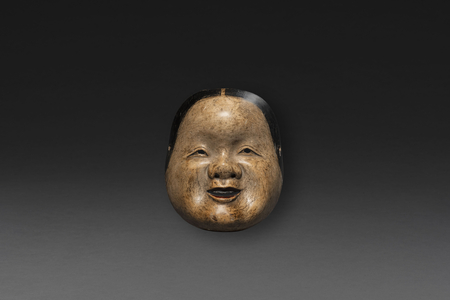Product Description
7820 A wood Kyōgen mask of Oto (Otafuku)
Japan 15th century Muromachi period
Inscribed:
Fukurai saku (made by Fukurai) and Mitsunao with kao (cursive monogram)
Dimensions: H. 18cm x W. 15cm x D. 17cm (7” x 6” x 6¾”)
Fukurai (act. late 14th to 15th centuries) was a master mask maker of the Muromachi period (1333-1573) from the Echizen region (present-day Fukui prefecture). There are several theories who Fukurai was – it is said that the Noh mask master Fukurai Ishiobyoe Masatomo was his full name; another theory suggests that Fukurai and Ishiobyoe were two separate Noh mask makers. In some records, Fukurai is counted as one of Rokusaku (six masters of mask making of the time, who were identified and selected by later generations).
During the medieval period, masks were rarely signed or sealed – most of the surviving examples by the old masters were authenticated by later masters, as with this example. On this present Kyogen mask, the attestation on the reverse is by Deme Mitsunao (d. 1750, artist name Hokan, the sixth generation of the Ono Deme Family) from the mid-Edo period. The Ono Deme family continuously produced Noh masks from the Momoyama period (16th century) and was one of three main hereditary Noh mask ateliers from 16th to 19th century: Echizen Deme family, Omi Iseki family and Ono Deme family.
Kyogen theatre (lit. wild words) is thought to stem from Sarugaku, a form of Chinese entertainment brought to Japan around the 8th century. It was a popular form of entertainment which included elements like mime, acrobatics and magic encompassing both drama and comedy. By the 14th century, these contradictive forms of Sarugaku had become known as Noh and Kyogen, respectively.
The mask of Oto (also called Otogoze, Otafuku and Okame, etc.) represents a young woman wearing a smiling, cheerful expression with large full cheeks. The origin of this mask character Oto is considered as Amenouzume, a goddess and the oldest dancer in Japanese mythology. Throughout the long history of Kyogen, the mask of Oto has been used in various plays, as an auspicious woman (a lucky goddess), a demon princess or an ugly woman, depending on the stories or periods.
For more about the artist, see Nakanishi Toru and Konma Kiyonori, Nohmen (Noh masks), (Osaka, 1981), p.136.
For other examples by the same artist, see:
Mitsui Memorial Musuem ed., Mitsui Kinen Bijutsukan shozo, kyu Kongo soke denrai nohmen (Noh masks previously in the collection of the head family of Kongo School, housed in the collection of the Mitsui Memorial Musuem), (Tokyo, 2008), p98-99, no. 32;
Kongo Noh-gakudo (The Kongo Noh Theatre) ed., Kongo soke no nohmen to nohshozoku (Noh masks and costumes in the collection of the head family of Kongo School), (Kyoto, 2018), p.52, 116, 131, no. 45;
Toru Nakanishi, The Beauty of Noh, (2001, Hyogo), p.41, 72, no.39.








